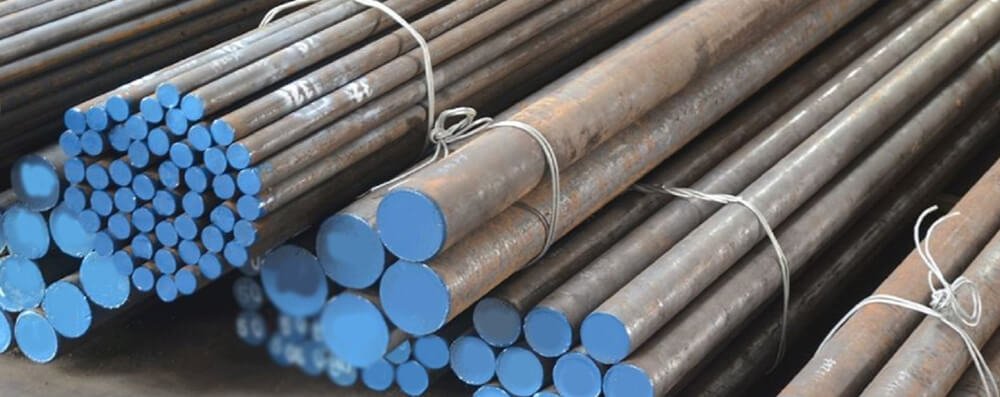Introduction
55C8 is a medium-carbon steel with excellent mechanical properties and versatility in both cold and hot working conditions. Known for its good wear resistance, strength, and toughness, it is frequently used in applications where components need to withstand high mechanical stress. The steel is often used in engineering and automotive industries, offering excellent machinability and the ability to be heat-treated for enhanced performance.
Properties of 55C8 Grade:
- Medium-carbon steel that provides a balance between strength, toughness, and wear resistance.
- Good machinability and formability, especially in normalized or annealed conditions.
- Versatile mechanical properties with the ability to be heat-treated for higher hardness and strength.
- Enhanced wear resistance and fatigue strength, making it ideal for demanding applications.
- Moderate weldability when properly prepared and with appropriate heat treatment.
- Commonly used in automotive and spring applications
- High fatigue strength for dynamic loading conditions
Uses/Applications of 55C8 Grade:
55C8 carbon steel is used in a wide range of industrial and automotive applications due to its robust performance in various conditions:
- Automotive: Used in the manufacturing of axles, shafts, crankshafts, gears, and other critical automotive components.
- Mechanical Engineering: Suitable for producing parts subjected to high wear and stress, such as bearings, gears, pins, and couplings.
- Construction: Can be used in the production of structural components, such as bolts, nuts, and washers.
- Industrial Tools: Ideal for manufacturing of tools and dies where toughness, hardness, and wear resistance are essential.
- Heavy Machinery: Used for parts that need to endure heavy loads and impact, including components in pumps, turbines, and presses.
Chemical Composition (Typical):
| Element | Content (%) |
| Carbon (C) | 0.52 – 0.60 |
| Manganese (Mn) | 0.60 – 0.90 |
| Silicon (Si) | 0.10 – 0.35 |
| Sulfur (S) | ≤ 0.05 |
| Phosphorus (P) | ≤ 0.05 |
| Iron (Fe) | Balance |
Mechanical Properties (Typical in Normalized Condition):
| Property | Value |
| Tensile Strength | 550 – 750 MPa |
| Yield Strength | 340 – 460 MPa |
| Elongation (in 50 mm) | 16% min |
| Impact Strength (Charpy V-notch) | 30 J min |
| Hardness (Brinell) | 170 – 210 HB |
| Hardness (After Hardening and Tempering) | 250 – 290 HB |
Physical Properties:
| Property | Value |
| Density | 7.85 g/cm³ |
| Modulus of Elasticity | 210 GPa |
| Thermal Conductivity | ~50 W/m·K |
| Specific Heat Capacity | ~460 J/kg·K |
| Electrical Resistivity | ~0.17 µΩ·m |
Forging:
- Forging Temperature Range: 950°C – 1150°C.
- Optimal Forging Temperature: Between 1050°C – 1100°C is ideal to achieve desirable mechanical properties and ease of forming.
- Cooling: After forging, slow cooling in air or controlled environments is recommended to relieve stresses and prevent cracking.
Heat Treatment:
- Annealing: Heat to 750°C – 800°C and cool slowly in a furnace to soften the steel and improve machinability.
- Normalizing: Heat to 850°C – 880°C and allow air cooling to refine the grain structure and increase toughness.
- Hardening: Heat to 830°C – 860°C and quench in oil or water for increased hardness and tensile strength.
- Tempering: Temper at 550°C – 650°C to adjust hardness and improve toughness for parts under mechanical stress.
Dimensional Tolerances:
- Hot Rolled Bars: Tolerances follow standard BS 970 or equivalent.
- Cold Drawn Bars: Offers better dimensional accuracy and surface finish.
- Forged Bars: Available in custom sizes with precise tolerances as per customer requirements.
- Available Sizes: Offered in various diameters and lengths depending on the application and customer specifications.
Machinability:
- Good machinability in the normalized or annealed state, making it easy to process with standard machining tools.
- Cutting, drilling, and turning are efficient with carbide or high-speed steel (HSS) tools.
- Surface finish is smooth after machining, especially when the steel is annealed.
- Lubrication and coolants are recommended to reduce tool wear and improve efficiency during machining operations.
Corrosion Resistance:
- Moderate corrosion resistance: 55C8 steel is susceptible to rust and corrosion when exposed to moisture or harsh environmental conditions.
- Protective coatings like galvanizing, plating, or painting can significantly enhance corrosion resistance.
- Proper storage is essential to prevent surface rusting and degradation during manufacturing.
Weldability:
- Moderate weldability: 55C8 steel can be welded using standard processes, but preheating is often recommended, especially for thicker sections.
- Preheating: Typically between 150°C – 250°C to prevent cracking during welding.
- Post-weld heat treatment: Recommended to restore mechanical properties and relieve stresses after welding.
- Welding Electrodes: Low-hydrogen electrodes and proper filler materials should be used for strong and reliable welds.
Available Form:
- Hot Rolled Bars
- Cold Drawn Bars
- Forged Bars
- Precision Ground Bars
- Custom Sizes: Available upon request.
- Standard Sizes: Various diameters and lengths for different industrial applications.
- Supplied in Normalized, Annealed, or Quenched and Tempered Conditions: Depending on customer needs.
Conclusion:
55C8 Carbon Steel Bar is a robust, versatile material offering an excellent balance of strength, toughness, and wear resistance. It is particularly well-suited for high-stress applications in automotive, mechanical engineering, and industrial sectors. With the ability to be heat-treated for improved hardness and strength, this steel grade provides great flexibility for a variety of applications. Though it has moderate corrosion resistance, proper protective measures and handling can ensure its durability and performance in demanding environments.
Related Products :20C8, ASTM A36, 20MN2, 55C8, 40C8, C45, ASTM SA-105, C50, C20, C55, EN3B, C55 Mn2, C60, C45, EN9, EN8, EN8D, IS 2062, EN43B, S355J2G3, S40C, SAE 1010, SAE 1018, ST52.3, 20MN2, Maps


